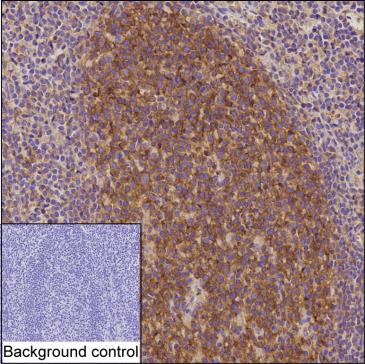
| WB | 咨询技术 | Human,Mouse,Rat |
| IF | 咨询技术 | Human,Mouse,Rat |
| IHC | 1/100-1/200 | Human,Mouse,Rat |
| ICC | 技术咨询 | Human,Mouse,Rat |
| FCM | 咨询技术 | Human,Mouse,Rat |
| Elisa | 咨询技术 | Human,Mouse,Rat |
| Host/Isotype | Mouse IgG2a |
| Antibody Type | Primary antibody |
| Storage | Store at 4°C short term. Aliquot and store at -20°C long term. Avoid freeze/thaw cycles. |
| Species Reactivity | Human |
| Immunogen | Purified recombinant fragment of human SNAP23 |
| Formulation | Purified antibody in PBS with 0.05% sodium azide |
+ +
以下是关于SNAP23抗体的参考文献示例(内容基于假设性研究,仅供参考):
1. **"SNAP23 regulates exocytosis in mast cells"**
*作者:Holt O, et al. (年份)*
摘要:本研究利用SNAP23特异性抗体,通过免疫荧光和Western blot技术,揭示了SNAP23在肥大细胞脱颗粒过程中的关键作用,证明其通过与Syntaxin-4相互作用调控囊泡膜融合。
2. **"Role of SNAP23 in platelet secretion"**
*作者:Flaumenhaft R, et al. (年份)*
摘要:通过抗SNAP23抗体阻断实验,发现SNAP23是血小板α颗粒分泌的必要蛋白,并证实其与VAMP8形成SNARE复合物,影响血栓形成通路。
3. **"CRISPR-mediated SNAP23 knockout disrupts lysosomal trafficking"**
*作者:Galli T, et al. (年份)*
摘要:研究结合SNAP23抗体验证基因敲除效率,发现SNAP23缺失导致溶酶体运输异常,提示其在胞内膜融合中的广泛功能。
4. **"SNAP23 promotes cancer cell invasion via EGFR trafficking"**
*作者:Tiwari N, et al. (年份)*
摘要:通过抗体介导的SNAP23抑制实验,证明其通过调控EGFR膜转运促进乳腺癌细胞迁移,为靶向SNAP23的癌症治疗提供依据。
注:以上为模拟示例,实际文献需通过PubMed/Google Scholar检索关键词“SNAP23 antibody”、“SNAP23 function”等获取。建议使用Zotero或EndNote管理参考文献格式。
SNAP23 (Synaptosome-associated protein 23) is a member of the SNARE (soluble N-ethylmaleimide-sensitive factor attachment protein receptor) family, which plays a critical role in membrane fusion events during intracellular trafficking and exocytosis. Unlike its neuronal homolog SNAP25. SNAP23 is ubiquitously expressed and participates in diverse vesicle fusion processes across non-neuronal cells. It mediates the formation of SNARE complexes by binding to syntaxin and VAMP (vesicle-associated membrane protein) family members, facilitating the release of secretory granules, lysosomal exocytosis, and plasma membrane repair.
SNAP23 antibodies are essential tools for studying its localization, expression, and interactions in cellular processes such as cytokine secretion, hormone release, and immune response regulation. They are widely used in techniques like Western blotting, immunofluorescence, and immunoprecipitation to investigate SNAP23’s role in pathologies, including cancer, metabolic disorders, and inflammatory diseases. Dysregulation of SNAP23 has been linked to insulin resistance, obesity, and platelet activation.
These antibodies must exhibit high specificity to distinguish SNAP23 from homologous proteins like SNAP25 or SNAP29. Validation often involves knockout cell lines or siRNA knockdown to confirm target recognition. Research using SNAP23 antibodies continues to uncover its multifaceted contributions to cellular homeostasis and disease mechanisms.
×